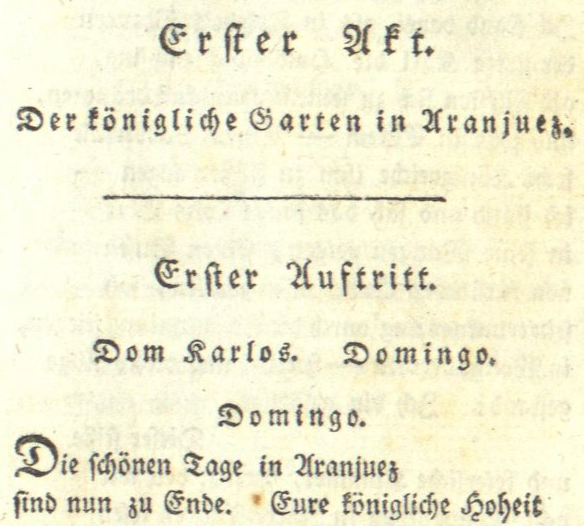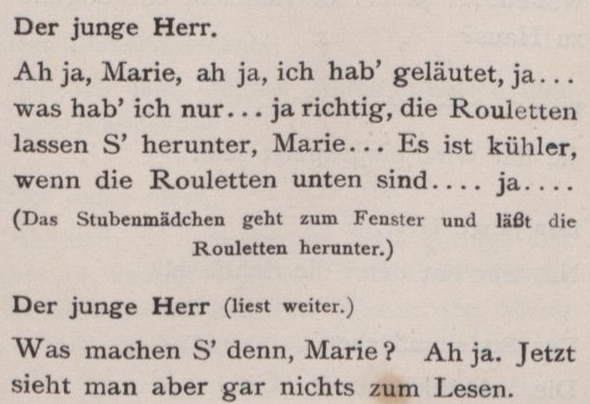Stage Directions
Stage directions are enclosed with a <stage> element:
<stage>[stage direction]</stage>
Different types of stage directions are possible and are treated differently:
1. Stage directions at the beginning of an act or entry: These stage directions determine the following section. They are usually after the respective section heading.
<div type="[e. g. scene]"> <head>[title of the entry]</head> <stage>[stage direction]</stage> <sp>[speech act]</sp> <sp>[another speech act]</sp> </div>
Stage Direction I

<div n="2"> <head><hi rendition="#g">Erſter Akt</hi>.</head><lb/> <stage><hi rendition="#g">Der königliche Garten in Aranjuez</hi>.</stage><lb/> <milestone rendition="#hr" unit="section"/><lb/> <div n="3"> <head><hi rendition="#g">Erſter Auftritt</hi>.</head><lb/> <stage><hi rendition="#g">Dom Karlos. Domingo</hi>.</stage><lb/> <sp who="#DOMI"> <speaker><hi rendition="#g">Domingo</hi>.</speaker><lb/> <p><hi rendition="#in">D</hi>ie ſchönen Tage in Aranjuez<lb/> ſind nun zu Ende. Eure königliche Hoheit<lb/>[...]</p> </sp> [...]</div> </div>
Source: Schiller, Friedrich: Dom Karlos, Infant von Spanien. Leipzig, 1787. [Facsimile 13]
2. Stage directions before the beginning or after the end of a speech act: Stage directions within an act that are not assigned to a speech act, but referring to the scene in general, are reproduced outside the contiguous <sp> elements in a <stage> element.
<div type="[e. g. scene]"> <head>[title of the entry]</head> <sp>[speech act]</sp> <stage>[stage direction]</stage> <sp>[another speech act]</sp> </div>
Stage Direction II

<sp who="#JHERR"> <speaker> <hi rendition="#b">Der junge Herr.</hi> </speaker><lb/> <p>Ah ja, Marie, ah ja, ich hab’ geläutet, ja …<lb/> was hab’ ich nur … ja richtig, die Rouletten<lb/> lassen S’ herunter, Marie … Es ist kühler,<lb/> wenn die Rouletten unten sind .... ja ....</p> </sp><lb/> <stage>(Das Stubenmädchen geht zum Fenster und läßt die<lb/> Rouletten herunter.)</stage><lb/> <sp who="#JHERR"> <speaker> <hi rendition="#b">Der junge Herr</hi> </speaker> <stage>(liest weiter.)<lb/></stage> <p> Was machen S’ denn, Marie? Ah ja. Jetzt<lb/> sieht man aber gar nichts zum Lesen. </p> </sp><lb/>
Source: Schnitzler, Arthur: Reigen. Wien, 1903. [Facsimile 41]
3. Stage directions within a speech act: Stage directions assigned to a speech act are reproduced within the <sp> element. If the stage direction is before or after the speaker's direct speech, it is given outside of <p>. If it is within the direct speech, the <p> element is not interrupted. Instead, the <stage> element is integrated into the <p> element.
<div type="[e. g. scene]"> <head>[title of the entry]</head> <sp> <speaker>[speaker]</speaker> <stage>[stage direction before the speech]</stage> <p>[speech] <stage>[stage direction within the speech]</stage> [speech]</p> <stage>[stage direction after the speech]</stage> </sp> <sp>[another speech act]</sp> </div>
Stage Direction III

<sp who="#ANA"> <speaker> <hi rendition="#b">Anatol.</hi> </speaker> <p> Ruhig <stage>(zu Cora)</stage> … Schlafen … feſt, tief ſchlafen.<lb/> <stage>(Er ſteht eine Weile vor Cora, die ruhig athmet und ſchläft).</stage> So … nun<lb/>kannſt Du fragen. </p> </sp><lb/>
Source: Schnitzler, Arthur: Anatol. Berlin, 1893. [Facsimile 27]